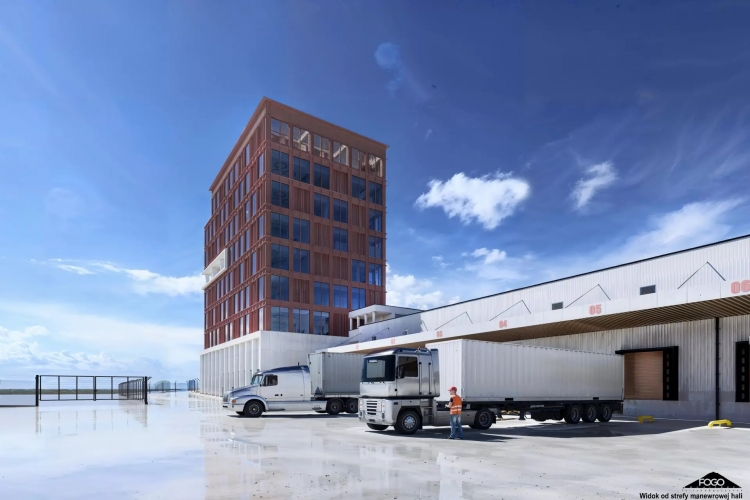An important investment is starting at the Port of Gdańsk
- Oprac. M.K.
- Kategoria: English zone
At the Port of Gdańsk, on a plot of over 2 hectares, a modern Integrated Border Control Point (ZPKG) will be built. The investment, located on Kontenerowa Street, right next to the Baltic Hub terminal and Pago cold storage facility, will significantly streamline the work of inspection services. It will thus respond to the growing need to handle the dynamically increasing volumes of cargo transshipped at the Port of Gdańsk.
On May 28, 2025, the Pomeranian Voivode Beata Rutkiewicz and the President of the Port of Gdańsk Dorota Pyć signed an agreement on the implementation of the first stage of the investment, which includes the development of design and cost documentation. The signing ceremony was attended by the Minister of the Interior and Administration Tomasz Siemoniak.
The Integrated Border Control Point is a strategic investment not only for the port but also for the entire maritime economy in Poland. Thanks to it, Poland will strengthen its position as a responsible EU member, committed to border security. The port industry will see real improvements in clearance procedures and efficiency in handling the ever-growing cargo volumes at the Port of Gdańsk.
We are all impressed by the momentum with which the Port of Gdańsk is developing. The Integrated Border Control Point project is a clear reflection of that. I had no idea that PLN 44 billion flows into the state budget from activities at the Port of Gdańsk. The Ministry of the Interior and Administration’s budget for this year is PLN 48 billion. You could say that thanks to port operations and your work, our ministry is financed. Polish ports must be competitive. That is why we must create the best possible conditions to channel as much cargo as possible through our ports - said Tomasz Siemoniak, Minister of the Interior and Coordinator of Special Services.
One Point, Many Services
At the Integrated Border Control Point, border inspections will be conducted on shipments of products entering the European Union, mainly through the Baltic Hub container terminal. Currently, inspection services operate in various parts of Gdańsk, working in a dispersed single- or double-shift model. The creation of the ZPKG will consolidate their operations in one modern facility. The site will host offices for, among others: the National Revenue Administration, Border Veterinary Inspection (GRIW), Border Sanitary and Epidemiological Station (GSSE), the Provincial Plant Health and Seed Inspection (WIORiN), and the Provincial Inspectorate of Commercial Quality of Agricultural and Food Products (WIJHARS). A total of 235 people will work per shift.
It is a great honor for us to carry out such an important investment. Important not only for the port but for the entire region and Poland. This project will improve the operations of various services responsible for efficiently carrying out cargo handling operations in the port. We will exercise due diligence to implement this project according to the agreed schedule. In these difficult and tense times, we must take special care in developing the Port of Gdańsk, above all by building its resilience. That resilience is built through investment. We want to be a sustainable port in the blue and green economy. The blue economy is nothing more than the maritime economy - based on new technologies, digitization, digital innovation, but most of all on people - said Dorota Pyć, President of the Port of Gdańsk.
Modern Infrastructure
The site for construction is already prepared. At the request of the Port of Gdańsk and Baltic Hub, land leveling was carried out, a post-war bunker was dismantled, and relocated to the area near Mrągowo.
According to the architectural concept developed by FOGO Architekci, the ZPKG will consist of a 9-story office building (6,200 m²) and a 3-story border control hall (9,200 m²). In front of the hall, a shelter with a staff room for security inspections has been designed. A parking lot for 230 employee vehicles will be located on the roof of the hall, accessible via an external covered spiral ramp situated between the buildings. It will be connected to the office building by a skybridge on the third floor of the hall.
The investment area will be fenced, with four entrances from the internal port road. There will also be a direct connection to the Baltic Hub terminal - tractors with containers for inspection will pass through two gates. Security checks will take place under the ramp, while full physical inspections will be carried out in the hall. The project also includes installations for renewable energy sources, with the option to feed surplus energy into the grid.
Phases and Financing
The investment has been included in the long-term investment plan for border crossings. The estimated cost of Stage I, related to the development of project documentation, is PLN 6.4 million net, while Stage II, covering construction and equipment of the facility, is estimated at PLN 157 million net. The completion of construction is planned for 2030.
Source: Port of Gdańsk Authority S.A.


